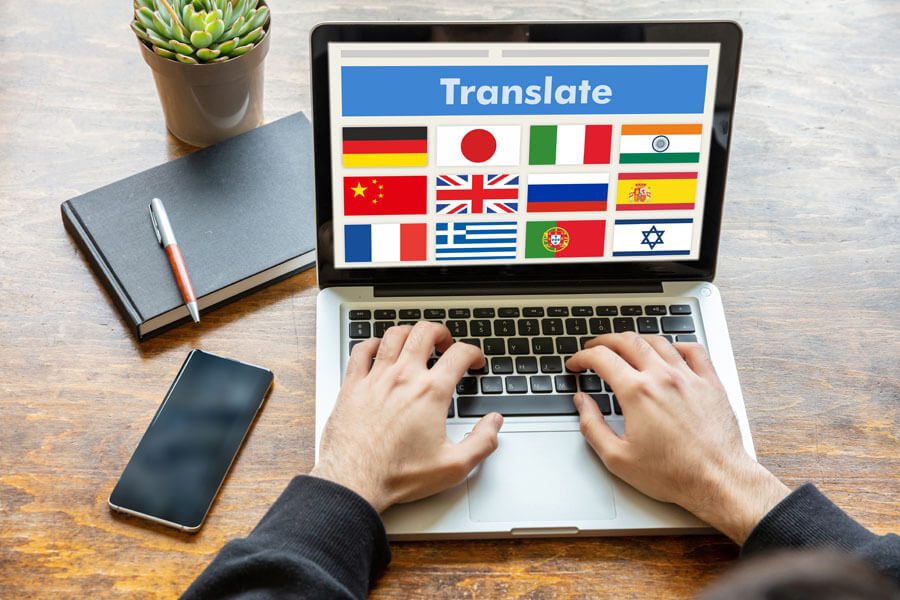
Google Translate is a great solution for people who want a quick translation on their web browser or phone. Just go to translate.google.com, type the original language, click the translate button, and view your translated target language.
The pros? generates fast, easy, and free translations of many different languages. The cons? The translations are far from perfect and lack the nuance of a real native language.
Join us as we explore the benefits and disadvantages of automated tools for translating professional websites.
The Evolution of Google Translate
Online machine translation made its big debut in 1997 with a service called Babel Fish. Users could type in foreign language phrases and get a quick translation in English, Korean, Portuguese, Spanish, and more.
In the early 2000s, entered the race to license this early translation technology. At this point, the technology was far from perfect. Google’s Sergey Brin highlighted the terrible translation quality in a customer’s email that was translated from Korean:
So Google launched its machine translation solution, Translate, in 2006. Originally, Google used SMT (statistical machine translation) to power its AI translation engine. By 2016, the team at Google added NMT (neural machine translation) to Google Translate. NMT uses artificial intelligence to learn languages and improve knowledge constantly–mimicking the neural network in the human brain. Nowadays, Google Translate offers automatic translations for over 100 languages. Translate is always evolving and is even built into Google Pixel earbuds for real-time translation.
In terms of accuracy, some languages perform better than others in Translate. According to a 2018 study, Translate had 50% accuracy for languages like Afrikaans, German, Portuguese, Spanish, Polish, Chinese, Croatian, Dutch, Galician, Greek, Italian, and Latvian. However, translations for Kurdish, Nepali, Latin, Malaysian, Urdu, Maori, Cebuano, Georgian, Persian, Punjabi, and Uzbek were only 20% accurate.
The Benefits of Google Translate
If you need a quick and free way to translate a website from English into new languages, Google Translate is a decent starting point. Let’s explore the benefits of using Google Translate.
Evolving Technology
Neural machine translation technology is constantly evolving. Like the human brain, it builds knowledge to get smarter over time. As technology improves, machine translations will improve in quality.
Quick and Easy Translation
Despite accuracy issues, Translate is a fast and simple way to translate text and websites. Google’s translation tools integrate with Chrome and Android devices to offer quick translations of websites all over the world. When you navigate to a foreign language website in the Chrome browser, a popup will offer free, automatic translations of 100+ languages.
Helpful Translation Drafting Tool
Machine translation will never outperform human translators, but it can still be a helpful tool for translators. Many professional translators use machine translation to do the first draft of a translation. The machine-generated draft is then post-edited by a skilled human translator. This can save time and lower translation costs.
Benefits for Internal Communication
High-quality human translation is an investment. In terms of ROI, you probably don’t want to invest in a professional translator for a website that’s not customer-facing. But for internal content like intranet sites, Google Translate can be a good fit. It’s not perfect, but it’s a helpful tool for delivering the basic meaning of your words to other people who speak different languages.
The Disadvantages of Google Translate
If you’re building a global brand and your reputation is important to you, using Translate on your public website is risky. Let’s explore some of the disadvantages of Translate.
Big Mistakes for your Brand
Google Translate is notorious for making big mistakes in translation. It ignores slang and idioms, misses nuances, and butchers grammar and syntax. These mistakes can be damaging to your brand. For example, take a look at this social post from Dominos that automatically translated from Japanese:
Formatting Problems
Text and number formatting is also tricky for Translate. Formatting problems on important pages like your brand’s pricing and checkout pages could hurt your business. Here’s a lighthearted example: in 2018, the Winter Olympics were held in Korea, and many teams relied on Google Translate to communicate. On one fateful day, a formatting error in Google Translate caused Norway’s Olympic team to accidentally buy a whole truck full of eggs. They only wanted 1,500 eggs, but the automatic translation altered the number format to 15,000 eggs.
Lack of Context and Cultural Nuance
Unlike a skilled translator, machine translation can’t always understand the context in a language. If you refer to Apple, does Translate know that you’re not talking about fruit? Not necessarily. Plus, Google Translate struggles with unique cultural nuances like traditions, gestures, local places, and more. Machine translation can’t decipher non-text elements like images and emoji, which can have wildly different meanings in different locales.
Problems with Jargon and Industry Terminology
AI doesn’t understand industry terminology as well as humans do. Translate still isn’t good enough for some industries. The Verge reported significant errors in Translate’s interpretation of medical documents. They found life-threatening mistakes. In one example, Google Translate turned “You can take over-the-counter ibuprofen as needed for pain” into Armenian as something completely different:
Possible Legal Trouble
As more countries regulate the internet with privacy and data security laws, good translations are incredibly important. If you publish a bad translation of your online policies, for example, you might be violating the law. In a 2015 study, researchers examined how a small commercial airline used Google Translate for its Terms and Conditions webpage. Unfortunately, the poor-quality translation led to significant financial and legal trouble for the business.


